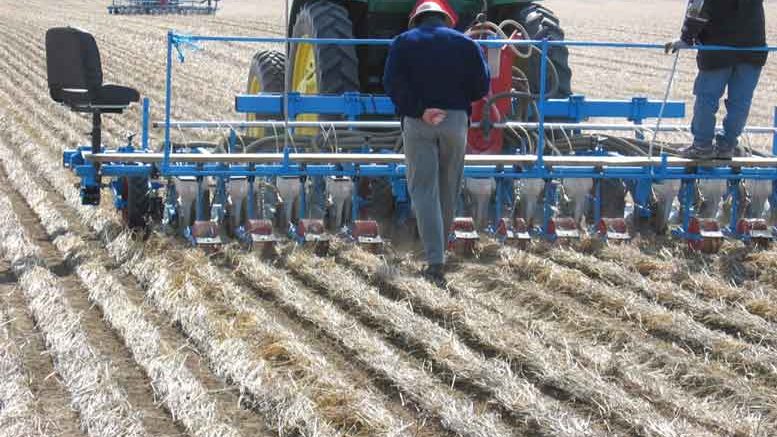|
Click to listen to this article
|
By Carrie H. Wohleb, Associate Professor and Vegetable Extension Specialist, Washington State University
This is the time of year when I get calls from growers who want help figuring out why their onions didn’t emerge or their seedlings are stunted. The following are some of the problems my colleagues and I have found while investigating stand issues in the Columbia Basin in Washington. Some of these problems may not be common in other parts of the country, and other regions may be subject to problems that are not seen in my area.
Poor Seed-to-Soil Contact
A firm and finely textured seedbed provides the seed-to-soil contact that onion seeds need to access moisture for germination. But clods and large plant residues create air pockets in the soil that can limit direct contact between onion seeds and soil. While irrigation can temporarily provide moisture to these seeds, drainage and quick drying often leaves them too dry to germinate. This problem is common with inexperienced onion growers who are used to planting crops with larger seeds where a smooth seedbed is less critical.
Soil Crusting
Soil crusting makes it difficult for onion seedlings to break the soil surface. In poorly aggregated soils, fine soil particles can settle into the spaces between larger particles, forming a seal, and then a hard crust can develop when the sealed surface dries after wetting.
One way to prevent crusting is to keep the soil surface consistently moist. Some growers apply a wetting agent or penetrant if a significant crust forms, which can be effective as a “rescue” treatment but is not generally recommended for prevention.
Soils with a lot of sodium are more likely to crust because sodium inhibits aggregation of soil particles. Since replacing some of the sodium with calcium can improve the soil structure, some growers inject calcium nitrate into irrigation water. But be careful because irrigation water with bicarbonate can react with calcium to form an insoluble precipitate. In that case, and for soils with a serious sodium problem, it is better to apply gypsum (calcium sulfate) in the off-season to remediate a sodic soil.
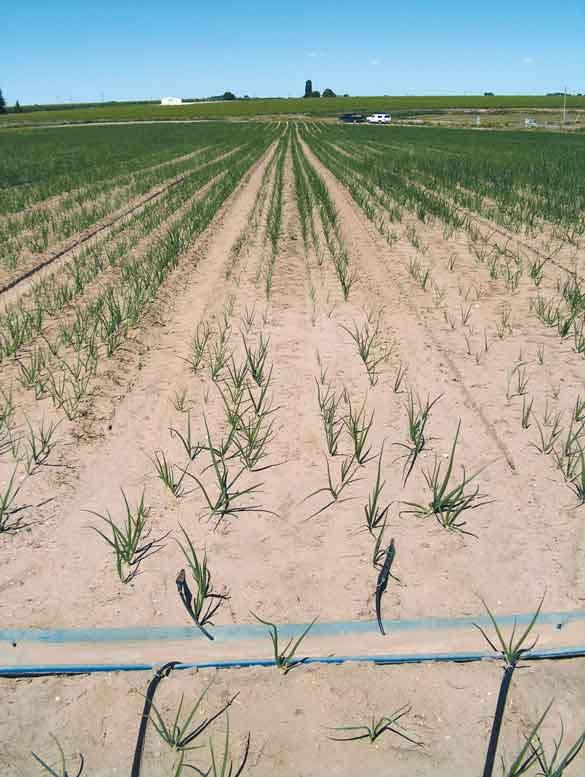
Acid Soils
Onions affected by soil acidity (pH < 5.5) exhibit slow, stunted growth with poorly developed roots. Columbia Basin soils are naturally neutral to alkaline, but acidification by nitrogen fertilizers and other inputs has gradually lowered the pH of some soils. Entire fields or scattered areas may be affected. In the latter instance, a composite soil sample for pH analysis will not indicate where stand problems might occur, and samples from a 0- to 12-inch depth may not give warning in cases where the soil is acid in just the top few inches. To verify a soil acidity problem, it is best to collect shallow soil samples from affected areas and compare them to those from healthy areas.
Growers can avoid soil acidification by limiting applications of acidifying fertilizers. But the best way to correct a serious soil acidity problem is to apply and incorporate lime before planting.
Soil Surface Heat
Tender onion seedlings exposed to high soil surface temperatures can be damaged. The main symptom is a white or yellow band of tissue at the soil line. Sometimes the leaf dies back, but since the growing point of the onion is underground and undamaged, the plant recovers by sending up another leaf.
The damage is more common on dark, sandy soils that heat up quickly. It is also associated with a sudden change from cool and overcast to hot and sunny weather; the protective waxy cuticle covering leaf epidermal cells is slow to develop when it is cool and overcast, which leaves onion seedlings poorly prepared to handle sudden heat.

Wind
Severe winds can make it difficult to keep the soil moist for germination, blow soils and onion seeds away, contribute to soil sealing, and injure onion seedlings via sandblasting or desiccation.
Irrigation can mitigate some of these problems, but sometimes it is impossible to keep the soil moist or prevent wind erosion. Some onion growers in the Columbia Basin plant into a strip-tilled wheat cover crop because the standing wheat provides onion seedlings some protection from the wind.
Rhizoctonia Stunting
Rhizoctonia is a soil-borne fungal pathogen that can cause stunting of onion seedlings. In the Columbia Basin, it is usually associated with onions that are planted into wheat cover crops.
Since Rhizoctonia needs a living host to survive in soil, the key to managing this problem is to break the “green bridge” between the wheat and onions. Growers who practice strip-tillage should kill the wheat cover crop at least two to four weeks before planting onions. The dead standing wheat still has value as a physical barrier to protect onion seedlings against wind and sandblasting.
The disease can also be reduced with broadcast and incorporated application of azoxystrobin (e.g., Quadris) before planting.
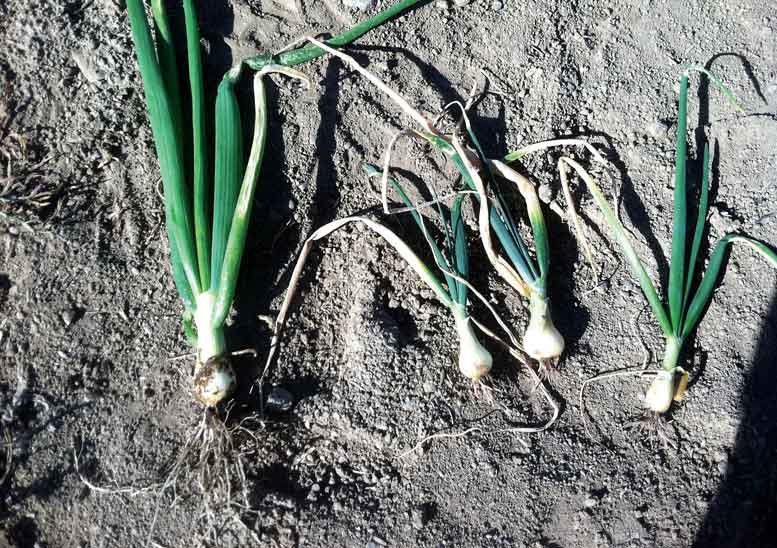
Pink Root
The soil-borne fungus Setophoma terrestris is the causal agent of pink root. It infects onion roots and impedes water and nutrient uptake, and stunting is one of the early symptoms. It is easy to diagnose due to a pink discoloration of the infected roots. Onion cultivars vary in susceptibility to pink root, so stunting can be particularly striking when a susceptible cultivar is grown adjacent to a tolerant cultivar. We tend to find pink root in onion fields that are grown using short rotation intervals that allow a buildup of fungal inoculum. Cereal crops in the rotation, especially corn, can host the pink root pathogen and make it difficult to break the disease cycle.
Pink root is managed with soil fumigants or by applying penthiopyrad (Fontelis) to the soil in a band below the seed.
Wireworms
Wireworms are the hard-bodied, copper-orange-colored larvae of click beetles. They reduce stands or stunt plants by feeding on seeds and roots and are important pests of numerous crops. In the Columbia Basin, onion fields occasionally need to be replanted due to significant stand destruction by wireworms.
If a previous crop had problems with this pest, then subsequent onion crops are likely to be at risk. If you do not know the field history, then you can look for wireworms before planting by sifting through several soil samples or by putting out bait traps to attract wireworms. But these methods do not work well if the soil near the surface is cold, which drives the wireworms deeper into the soil, or if you do not do a thorough check.
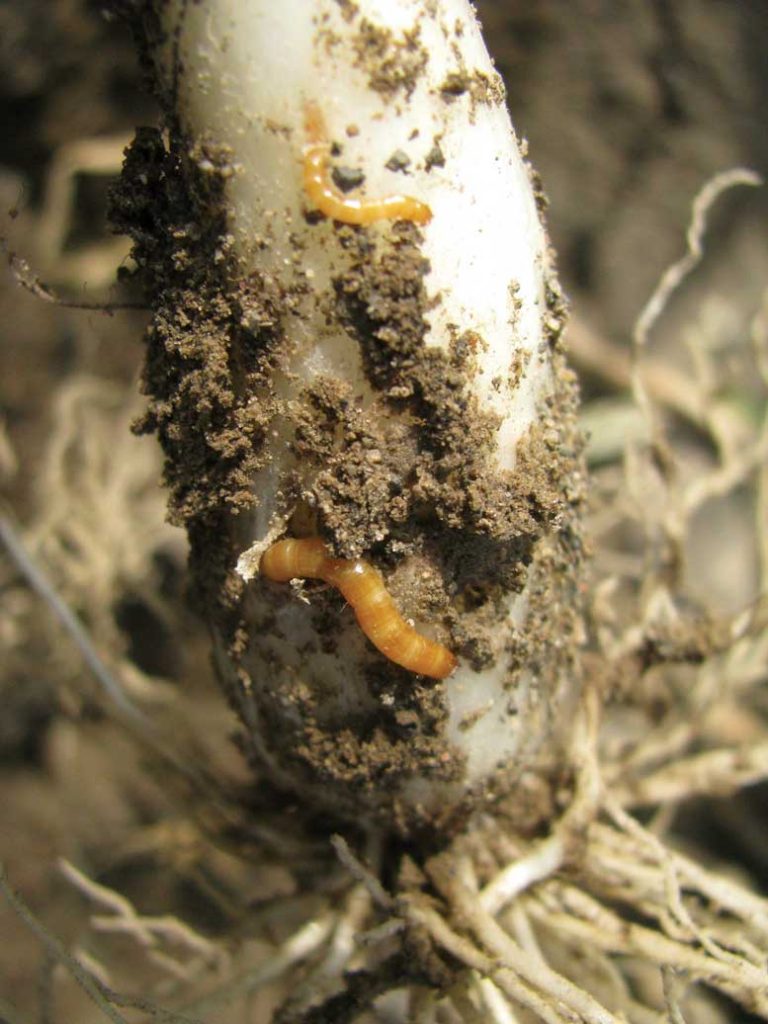
Seedcorn Maggots
Seedcorn maggots are the larvae of a small fly species. They feed on seeds and roots of many different vegetable crops, often resulting in stand issues. The adult flies prefer to lay their eggs in recently tilled soil and are especially attracted to decomposing organic matter, such as manure and plant residues.
Chlorpyrifos (Lorsban) was commonly used to control seedcorn maggot, but this insecticide is no longer registered for use on onions. Seed treatments with insecticides (imidacloprid, clothianidin, thiamethoxam and spinosad) can be used to minimize damages, but these insecticides must be ingested by the insect and are a little slower acting compared to chlorpyrifos, which killed the pest on contact.
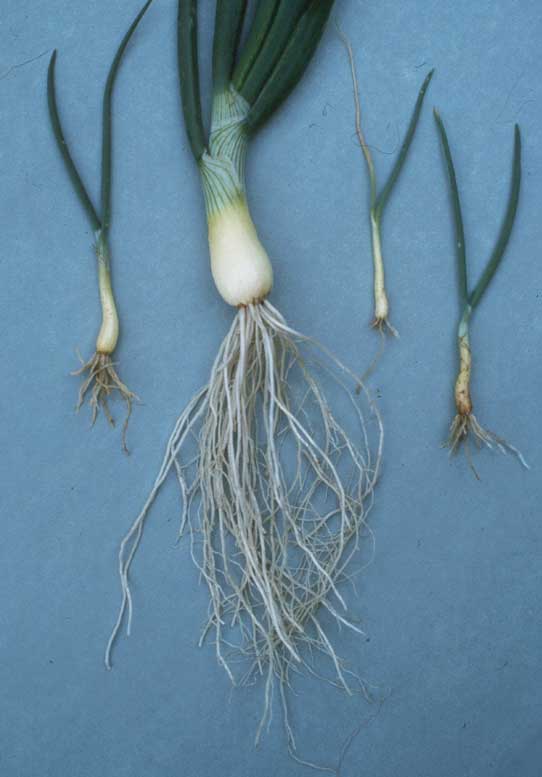
Stubby-Root Nematodes
Stubby-root nematodes attack roots, causing them to be very short and stubby, and infestations result in significant stunting of plants. Soil samples from areas where onions are stunted can be submitted to a nematode assay lab for verification. Stubby-root nematodes are found in the upper soil profile when the soil is moist and about 70 degrees Fahrenheit, but they tend to move deeper when it is drier and temperatures are cooler or hotter. It is possible to misdiagnose this problem if soil samples are not collected deep enough to reach the nematodes.
Soil fumigation with 1,3-dichloropropene (e.g., Telone II) or applications of oxamyl (e.g., Vydate) are the most common treatments used to manage stubby-root nematodes in onions.
Herbicide Carryover
Onion stands can be compromised by “carryover” of herbicides to which onions are sensitive. In the Columbia Basin, stand problems have occurred when imazamox (e.g., Raptor) was applied to a previous bean crop, and when metribuzin (e.g., Dual) was used the previous season.
Most herbicide labels state plant-back restrictions and provide details about how quickly the herbicide degrades under different conditions (pH, rainfall or irrigation, soil texture, etc.). This information should be carefully considered prior to planting onions.
Herbicide Injury
Herbicides that are labeled for use in onions can cause yellowing, curling, or necrotic leaf tips, but the crop usually grows out of this injury if herbicides are applied as directed. Stand reduction is less common, but can occur when herbicide applications are poorly timed. For example, glyphosate (e.g., Roundup) applications intended for the post-planting to pre-emergence window can cause stand losses when they miss their mark and are made too late. This tends to be a bigger problem in seasons where cool spring temperatures result in non-uniform emergence or when it is too windy to make pre-emergent applications.
Avoid this problem by surveying the field thoroughly before making the application.
Several pesticides are mentioned in this article. Always read and follow the instructions on the product label. It is up to you to make sure they are used appropriately.
Author’s note: Many of these problems were investigated by my colleagues, Lindsey du Toit, Washington State University (WSU) plant pathologist, and Tim Waters, WSU vegetable Extension specialist, and by my predecessor, Gary Pelter, retired WSU vegetable Extension specialist. I want to thank them for sharing their expertise and for being excellent collaborators.

